

If you want to see your abs, you're going to have to lose A LOT of body fat.
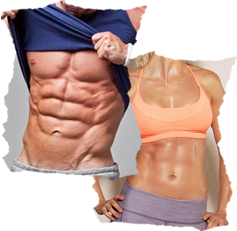
Everyone is a bit different, but typically you can see all of your abs when you are between 7-12% body fat. This varies from person to person based upon fat distribution patterns, body shape/type, hormonal fluctuations, fluid retention, and amount of muscle.
Personally, I don't see my abs until I'm about 7.5%-8% body fat; the trouble is anything under 10% for a man -- or 12% for a woman -- increases risk of injury. So, if I really want to have a six pack, I have to risk injury to my muscles and joints. In other words, my body is designed to be lean, strong, and capable; but, a six pack is not natural.
Of course, I've tempted fait in the past to see if I could get six pack abs. As it turns out, I have an 8-pack, which was pretty cool to find out! Anatomically speaking, my "six pack muscle" (rectus abdominus) is divided into 8 sections, rather than six. This is just the way I was born.
You see, we are all unique, but there are also commonalities between us. For example, if you have 10% body fat or less (12% for women) and you can't see your abs, there's a good bet one of two scenarios are taking place:

 You're inflamed.
You're inflamed.

 Your pelvis is out of position.
Your pelvis is out of position.
Inflammation means your body is attempting to heal. Generally speaking, swelling related to exercise will last up to 48-72 hours, and that's perfectly normal. However, when swelling lasts longer -- or begins to stiffen (i.e. pitting edema, which has a boggy, more solid feel to it) -- you might want to see a Physical Therapist or Massage Therapist for some help bringing it back down.
During a period your body is inflamed from exercise, it's a good idea to rest at least that 'type' of exercise. This means heavy weight training can be alternated by days of outdoor activity, cardio, muscle balancing, or bodyweight training. However, we wouldn't want to do another heavy workout until all inflammation has calmed down.

No matter the cause of inflammation, we're going to need to work on balancing muscles, stabilizing joints for increased strength and stability, and healing any past injuries, trauma, or strain on another bodily system. Remember, we need to take care of your body's highest priority first, in order for it to lose body fat or add definition.

You'll want to consider:
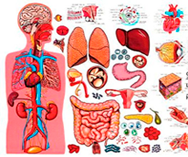
First, let's start with bodily systems. When you go to an emergency room, they evaluate you from the most critical organs (i.e. your heart, brain and spinal cord) outward. This is to protect your life, but the same philosophy can be applied to getting a flat stomach: start with the most critical issue first and optimize your health, from highest priority to lowest.
For example, high cholesterol and triglycerides may be placing too much strain on your heart, so it will be difficult to lose that last bit of fat. Or you might have trouble digesting meals, so your body holds onto an extra bit of fat and ends up swollen. Another common issue is spinal position -- since so many people spend years of their lives sitting -- which affects the length and position of muscles all over the body and your ability to communicate with them.

Now, let's move onto muscle balancing. Typical muscle imbalances for the highly trained involve:
Most people who exercise tend to overtrain the side of the body they can see in the mirror.

We usually over-train our pecs, over-lengthen our lats, and round our shoulders while tipping our chins up. It's a natural tendency, as it's normal to want to look great head-on. However, it's a failed strategy for training, since our bodies actually look -- and function -- much better when symmetrical.
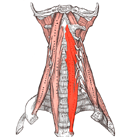

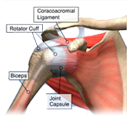

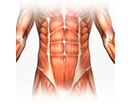
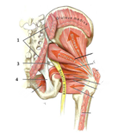
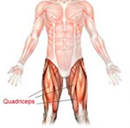

Your quads are also balanced by your calves while walking and running. Basically, your calves anchor your knee joint from the back side when your quads pull your lower leg bone forward with every forceful contraction. This is why it's so important to add a heel raise to exercises like step ups, squats, and lunges from time to time.
These tiny little muscles are in the bottom of your feet and work together with ligaments and fascia to form your arches. These "foot intrinsic muscles" are excellent shock absorbers with every step when properly trained. They can take a lot of pressure off your ankles, knees, hip rotators, and low back; similarly, if forgotten, extra pressure translates all the way up the chain and can cause early fatigue and injury. It seems silly to train the bottoms of your feet for abs, but let's face it: seeing your abs means you're dialing everything in and optimizing your body; that's how to get under 10-12% body fat without injury.
Depending on the exercise, you might be doing an isotonic exercise for your biceps and lats, but an isometric for your core (pull up). In another example, like a squat with rotational press, you will be using your core muscles to move, while also using other muscles to move. So, a squat with rotational press would be considered an isotonic exercise all around.
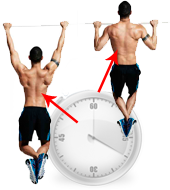
I feel it's impossible to over-emphasize that quality of movement comes first. You see, there's something called muscle timing, which is how we determine if a muscle fires at the appropriate time during an exercise. For example, a lot of people struggle with pull ups, and this is often because they are trying to do the exercise with their biceps and forearms, rather than their lats. When you learn to recruit your muscles from your spine outward -- and feel your entire muscle contract -- you are ready to progress speed.
Certain muscles naturally have more Type IIa and IIb muscle fibers, because they are meant for sprinting. Other muscles, like your lats, have more Type I muscle fibers because they are meant for posture and strength throughout your day.
However, the most important take-home lesson is to train at all speeds, with all muscles.
This means superslow (10 seconds concentric/eccentric), normal (2 seconds concentric, 1 second isometric hold, 4 seconds eccentric), and sprint (as fast as you can go without breaking form).
Sometimes, you'll want to train your bigger muscles first, and other times, you'll want to tire your little muscles at the beginning of your workout. This is called muscle sequencing.
Fatiguing smaller muscles first -- like doing multiple sets of biceps curls before doing pull ups -- forces you to recruit larger muscles to do the exercise. Also, it gives you an opportunity to emphasize strength sets on your biceps, before they become tired from doing pull ups. The main disadvantage is that your biceps are supposed to help during a pull up, and now they are basically useless; so, you're unlikely to make a whole lot of progress on pull ups this way.
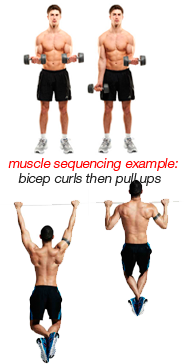
There are a variety of ways to sequence your exercises, and a purpose for each. As another example, you might choose opposite muscles, back to back, to create supersets or giant sets. The advantage of choosing opposite muscle groups like your biceps and triceps -- or abs and back -- is that you will turn off the signal to your biceps when you turn on your triceps, and vice versa with non-weight bearing exercises. This is called reciprocal inhibition.
In the biceps/triceps example, let's assume you want to build strength in your biceps. Choose lower reps (strength) for your biceps, then higher reps (endurance) for triceps. The goal is to turn 'off' the signal to the muscle you are targeting for strength and provide it with immediate rest, or as close to as possible.
In the abs/back example, it's a bit more complicated, since some of the muscles in your low back have the same action as your abs. So, I'll just provide two practical examples of giant sets you can do to alternate abs/back strength and endurance:

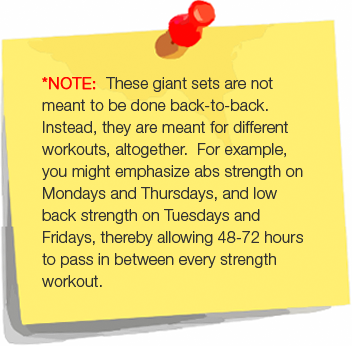
Getting a flat stomach means building abs and back 'strength', but it also means building abs and back 'length'. You see, strength is only 50% of the puzzle. When your muscles can fully contract and stretch, they are more powerful and won't get tired as quickly. If you've been stuck at about the same body fat percentage or physique for awhile now, you may strongly want to consider alternating flexibility workouts with your current routine.
This brings up the topic of mixed intensity, which is smart from one day to the next, but also within a given workout. By mixing up your intensity, from a full intensity, explosive first rep of every set, to a sprint-based pace for the next minute or so, and then slow and steady until the end, you will be training all 3 energy systems in your body. This maximizes the metabolic effect of every set you do, which has a compounding effect on each workout, periodization phase, etc.
When you see results accelerate over time, it's exciting. And being excited is going to keep you motivated. If you're not seeing some sort of result every 2 weeks, it's time to change something up.
Do not underestimate the importance of your state of mind.
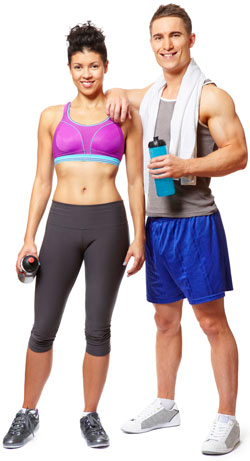
By far, the most important thing I can say when it comes to exercise and getting a flat stomach is to stick with it, and that'll only happen if you're enjoying yourself along the way.
If your organs are healthy, your digestive health is awesome, your muscles are balanced, and your energy level and focus are unstoppable, you're doing great. The final steps involve learning more about your body and how you can influence the way it feels throughout the day.
One great example is the ideal timing for sleep each night. It might turn out you are someone who functions best on 7 or 9 hours of sleep, rather than 8. You might be getting to bed late and waking up late, but you may find out you get better sleep during the darkest hours of the night. Or you might be over-sleeping by 15-30 minutes, because you have sleep cycles that last 2 hours and you wake up 8 hours and 15 minutes into your sleep. This means you'll wake up foggy, start slowly, and end up getting less from your day.
Also, certain foods will make you feel 110% (your "superfoods") vs others which will make you feel about the same --or worse than -- before you ate them. You may want to consider starting each day with your own superfoods, which will set the tone for how you eat -- and feel -- for the rest of the day. And, as much as possible, eliminate any foods that lower your energy level.
Think about it this way -- if you have a flat stomach, less than 10% body fat, and you're eating food for energy, it's a good bet you're fully optimized. This is the spitting-image of health, but always needs to be compared to what's going on inside your body, how you feel, both physically and emotionally, and any other known health variables. Remember, health isn't about comparing you to someone else; instead, it's about comparing your current health to the best it could be, given the circumstances.
Extreme dieting and spending hours in the gym works... for awhile. But, then you get hurt, a bit older, and a lot of tendonitis and joint pain.
Balance your body, design your exercise program the right way, or let us do it for you. This is your body -- and health -- we are talking about. If you'd like us to take away the guess work, we'll be happy to. Simply click below to activate your membership.
Besides, if you get even half the results of our other clients, you won't be sorry. Go ahead and click below to activate your membership right away: (*results may vary)
